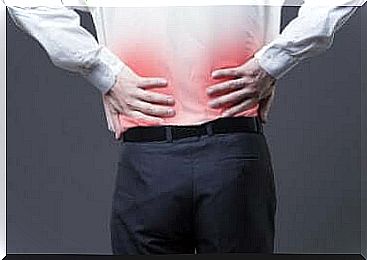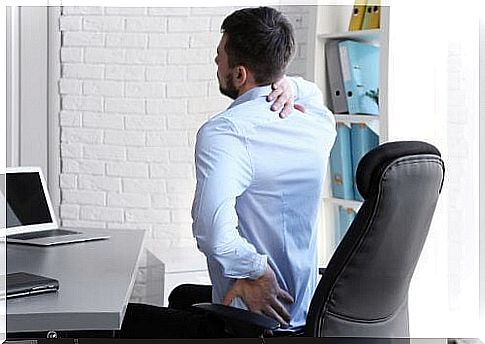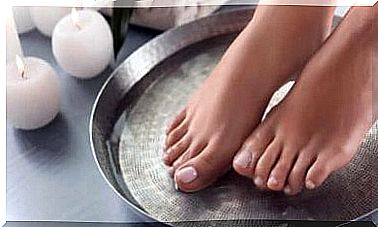Lumbar Back Pain: Additional Tips On Therapy
Lumbar back pain is a common ailment. But there are simple preventive and treatment measures that are very useful. Find out more about it today.

Lumbar back pain can be alleviated through various therapies. But there are also simple measures that you can take so that the unpleasant complaints in the lower back do not occur at all or disappear again more quickly.
It is one of the most common ailments in our modern sedentary society. Around 80% of the adult population has suffered from lower back pain at some point. This comes from the statistics of the National Institute of Neurological Disorders and Stroke (USA).
Women and men are equally affected. Consider our tips that can help you in this case.
Lumbar back pain reduces the quality of life

A study published in a UK health magazine and carried out in 187 countries found that lumbar back pain is one of the most common causes of absence from work.
Over 4 million working days are lost every year! With the right treatment, the pain usually disappears, but chronic suffering could also develop if there is no therapy.
The aforementioned study also found that around 30% of those affected are not treated properly and therefore develop chronic pain or have low back pain recurring in less than a year. Even more worrisome is the result of a recent scientific study published on Boston Medical Center was released. It shows that inadequately treated back pain is related to death in 50% of the participants.
“Lumbar back pain interferes with daily activities and the elderly try to avoid them for fear of symptoms. As a result, they gain weight or develop other chronic health conditions that ultimately lead to premature death. ” This is the statement from Eric Roseen, who led the aforementioned study.
Lumbar back pain: better habits bring good results
It is therefore essential that you treat your lower back pain appropriately and not let it get worse. It is best to have a specialist examine you and advise you.
In addition, we recommend the following measures for preventive or supportive treatment in order to bring the situation under control.
1. Lumbar back pain: heat and cold treatments

Cold compresses are used to reduce inflammation and swelling for the first 24 hours after the pain starts.
- Use an ice pack and wrap it in a cloth or a fine towel.
- Then place the ice pack on the painful area for 10 minutes.
- If you wish, you can then take a 10-minute break and then apply the ice pack again.
The heat treatment should not take place until 24 hours after the symptoms appear, otherwise the inflammation could worsen.
- Prepare a hot water bottle and wrap it in a towel.
- Place the hot water bottle on the painful area.
2. Lumbar back pain: don’t stay in bed for long!
The National Institute for Neurological Disorder and Stroke warns that lying down for long periods can make lower back pain worse. It could also cause other symptoms such as depression, blood clots, or muscle atrophy.
The Medical School of Harvard also advises lying down as little as possible. The sleeping position is also important during the night: It is best to sleep on your side with your legs drawn up and a low pillow. Also place a flat pillow between your knees. A hard mattress is preferred.
The doctor or therapist can recommend rest time, but it should not be overdone.
3. Lumbar Back Pain: Correct Posture Can Help!

The correct posture when sitting is fundamental: Make sure that the backrest is ergonomic and as straight as possible at a 90-degree angle to the seat.
The back should always be kept straight, with the feet completely supported on the floor. Also, make sure that your knees should be level with your hips.
When you work on the computer, the screen should be placed at eye level. The gaze should not have to be directed either up or down. The distance between your arms and the keyboard shouldn’t be too big, because you shouldn’t have to stretch your arms. Likewise, if you’re not using a computer but need to write something, maintain the same posture with your back straight and your hips and knees aligned. Always keep your feet on the floor.
Avoid a sagging, hunched back at the desk. If you have to read something, bring the paper or book at eye level.
Posture is also important for leisure activities! If you relax while watching TV, you should still keep your back upright while sitting and not just hang down. Avoid hunching your back and keep your head upright.
4. Healthy Diet!
That’s right, diet is also of great importance if you have back pain. Because being overweight leads to increased stress and, as a result, more frequent pain.
Note that a sedentary lifestyle promotes appetite! The best way to learn to resist temptation. In addition to other measures, consume enough water to reduce your weight.
Calcium-rich foods such as sour fruits, milk, cheese, and yogurt, and green vegetables such as cabbage and broccoli strengthen bones. In addition, foods with vitamin D are important. These include sardines, salmon, and eggs.
Short daily sunbathing is also important in order to synthesize sufficient vitamin D. However, don’t forget that too much sun is harmful.
5. Lumbar Back Pain: Practice Yoga!

Not everyone has the prerequisites for various movement therapies. For example, 12 participants in the study mentioned had negative effects.
6. Lumbar Back Pain: Don’t bend your back to lift weight
When sweeping, walking, cooking, or lifting things, you should take special care not to put unnecessary strain on your back. Try to stand upright and if necessary just bend your knees with your back straight to pick something up from the floor.
7. Don’t stand on tiptoe!

8. Lumbar back pain: don’t carry heavy things!
Everyday activities often involve carrying heavy objects; for example when shopping or when you have to transport your laptop. Try to avoid carrying heavy weights as much as possible.
Use a wheeled shopping cart when shopping, making sure that the handle of the shopping trolley is level with your arms so you don’t have to bend over.
If you follow our recommendations in addition to the right treatment, you can prevent your back pain from worsening or becoming chronic.









